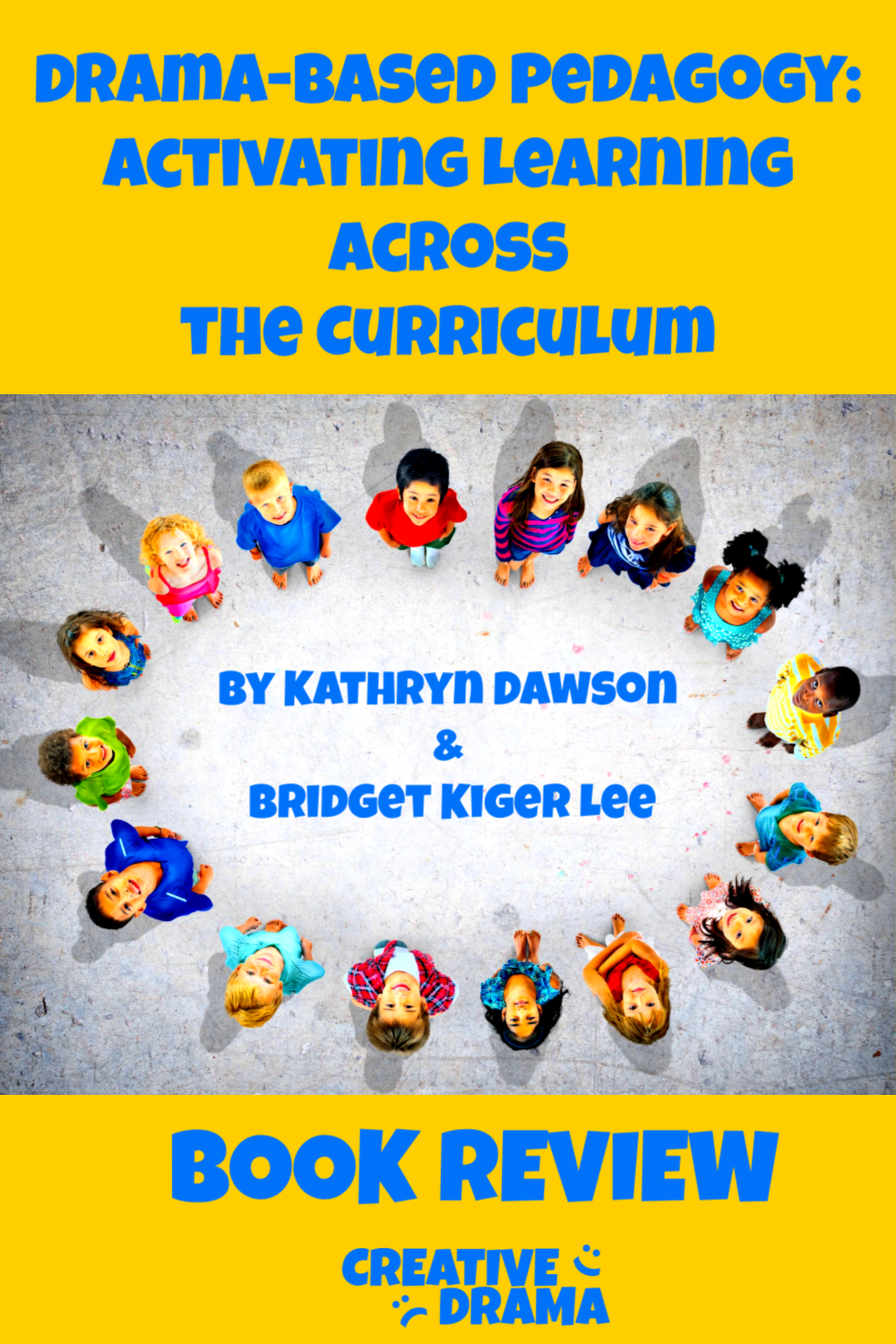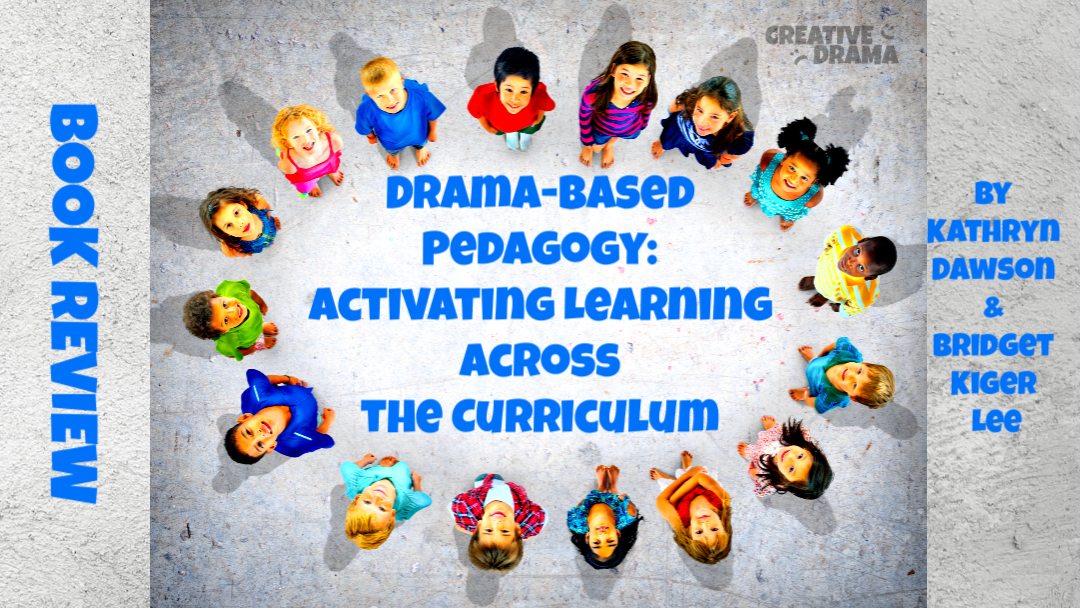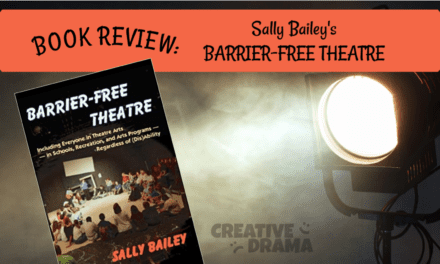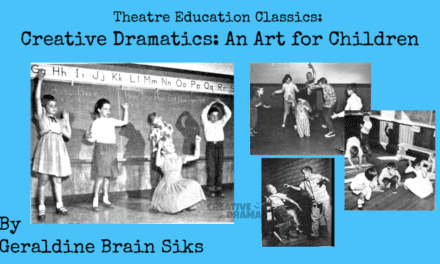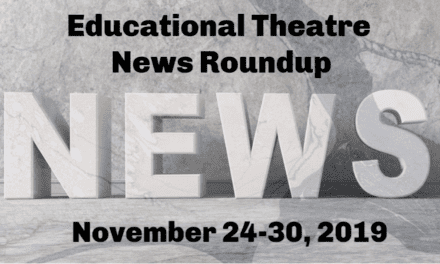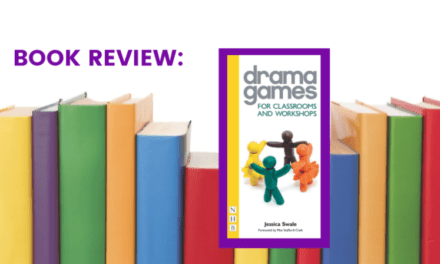INTRODUCTION
With Drama-Based Pedagogy: Activating Learning Across the Curriculum, Kathryn Dawson and Bridget Kiger Lee give teachers an organized, actionable, achievable way of integrating drama and drama-based strategies into their classrooms. It’s an excellent and comprehensive guide to DBP.
There are numerous connections between Drama-Based Pedagogy and Brian Edmiston’s Transforming Teaching and Learning with Active and Dramatic Approaches: Engaging Students Across the Curriculum. Bridget Kiger Lee was a post-doctoral research fellow in Edmiston’s department at Ohio State when she co-authored the book. Edmiston wrote the Foreward, saying that if the book had been on his desk when he was a beginning teacher, he “wouldn’t have to founder so often.” (xi)
In the Introduction, Dawson and Lee explain Drama-Based Pedagogy: Activating Learning Across the Curriculum is a book for elementary teachers covering may subject areas and subject area teachers as well as theatre teacher-directors.
As with Edmiston’s book, readers will benefit from some familiarity with constructivist pedagogy, Augusto Boal’s Theatre of the Oppressed, and Lev Vygotsky’s theories of learning.
ORGANIZATION
The book’s organization is one of its greatest strengths; Dawson and Lee divided their work into three main parts, answering basic questions about Drama-Based Pedagogy:
I. Why Use DBP
II. What Is DBP?
III. How Is DBP Used?
Each part has several chapters, and Drama-Based Pedagogy contains plenty of bulleted lists, graphic organizers, inset quotations, and tips distributed throughout the text. The included photographs are very small, though most effectively illustrate the concepts they’re communicating. Dawson and Lee provide lots of quotes from practitioners of DBP as well.
In addition, the book’s front matter:
- Acknowledgements
- Foreward
- Introduction
And Appendices:
- Glossary
- Related Resources – Books, Studies, Reviews of Research, and Quasi-experimental studies
- Works Referenced
- Online Resources
supply enough further reading to support a teacher new to drama-based techniques and keep a master teacher learning for many months.
PART I: Why Use DBP?
Dawson and Lee take Chapter 1:The Origins of Drama-Based Pedagogy to clarify the process-based, in-classroom use of “drama” in education, contrasting it with “theatre.” Drama-based pedagogy is for learners to experience, not to performance in front of an audience.*
In Chapter 2, the authors cover definitions of Drama-Based Pedagogy and some of its tenets:
- Active and Dramatic Approaches engaging Ensemble, Imagination, Embodiment, and Narrative
- Academic, Affective, and Aesthetic Outcomes supporting Intellectual, Socio/Emotional, and Artistic learning
- Dialogic Meaning-Making within a student’s Zone of Proximal Development through the use of the DAR (Describe, Analyze, Relate) routine
Dawson and Lee regularly reference these concepts in Drama-Based Pedagogy, and they give thorough explanations of each. Their writing is clear and convincing; though I was already familiar with many of the concepts, I think that beginning teachers will find it easily digestible.
Chapter 3: Introduction to DBP
The third chapter of Drama-Based Pedagogy breaks DBP into five steps. The authors describe it as a “flexible, multi-step planning process” (32) and it is!
When placing DBP into “the US educational context,” Dawson and Lee provide a “Stakeholders in the United States Educational Context” with three layers: the school, the teacher, and the student. They include the district, state, and federal governments influence on educational policy in the “school” level. I’d add that the opinions of parents and community input affect district-level decisions often enough that they should be their own level on the bullseye.
In the Steps section of the Learning Design Process, the authors deliver a great balance of the questions educators need to ask and answer. Moreover, they provide specifics on how those answers might look for a few specific lessons: the Pythagorean Theorem, Rumpelstiltskin.
The five steps:
- Consider Stakeholder Intention
- Identify What Students Need to Know
- Define Relevant Student Connections
- Choose Strategies and Performance-Based Assessment
- Construct a Design That Engages, Explores, and Reflects
are easy to remember, and Dawson and Lee have a handy visual organizer that should work for visually-oriented teachers (I’m pretty sure; graphic organizers rarely help my own learning process!).
PART II: WHAT IS DBP?
Part II: What Is DBP, the longest and most content-heavy section of Drama-Based Pedagogy, covers the four categories of DBP strategies:
- Activating Dialogue
- Theatre Game as Metaphor
- Image Work
- Role Work
Each category gets its own chapter; each chapter has a similar organizational method.
There is a photo of a class-designed DBP Reflection Board at the beginning of this section; unfortunately, I couldn’t read any of the comments on the board. The bulletin board itself became a resource tool for the students to utilize in independent learning.
Dawson and Lee have developed a pyramid – which is a familiar shape to educators (Bloom’s Taxonomy!) – to give teachers an idea of how the different strategies build upon each other. They suggest beginning with Activating Dialogue strategies.
In addition, there’s a table of four categories with columns for the main questions they cover in each category’s chapter:
- Strategy Names
- What Is It?
- Why Use It?
- When Is It Used?
There’s an explanation of the organization for each strategy, which follows a game setup familiar to many theatre teacher-directors:
- Source
- Number of Players
- Space
- What is it and Why Use It?
- Directions
- Reflection
- Possible side-coaching
- Possible variations/applications
A word about the “Source”: because theatre games are most often passed from thespian to thespian via active participation, lots of games have multiple names, a dozen variations, and inventors/creators lost to history. It’s often hard to say exactly who designed a game, unless it’s one of Viola Spolin’s or Augusto Boal’s classics. So the “Source” is not necessarily the creator.
There is a parameter that’s usually included with theatre games “missing” – Age Range – but Dawson and Lee often remind the reader that the strategies can be adapted to a wide range of ages and abilities. They also supply variations and applications for each of the (94!) strategies, suggesting how it might work in a particular content area or with a concept.
Finally, the authors provide a comprehensive list of DBP Strategies (53-54), categorized and sub-categorized, that could serve as an easy reference once an educator has a firm grasp on her options.
Each of the following four Chapters have sections for each subcategory of strategies that:
- Answers the “What, Why, When,” including an example of a teacher’s choice of strategy
- Address the Academic, Affective, and Aesthetic domains of knowledge and skills ,
- Supply Context Needs questions
- Detail the (typically 6-8) strategies that teachers can apply
I’m going to provide explanations and commentary for the categories and subcategories.
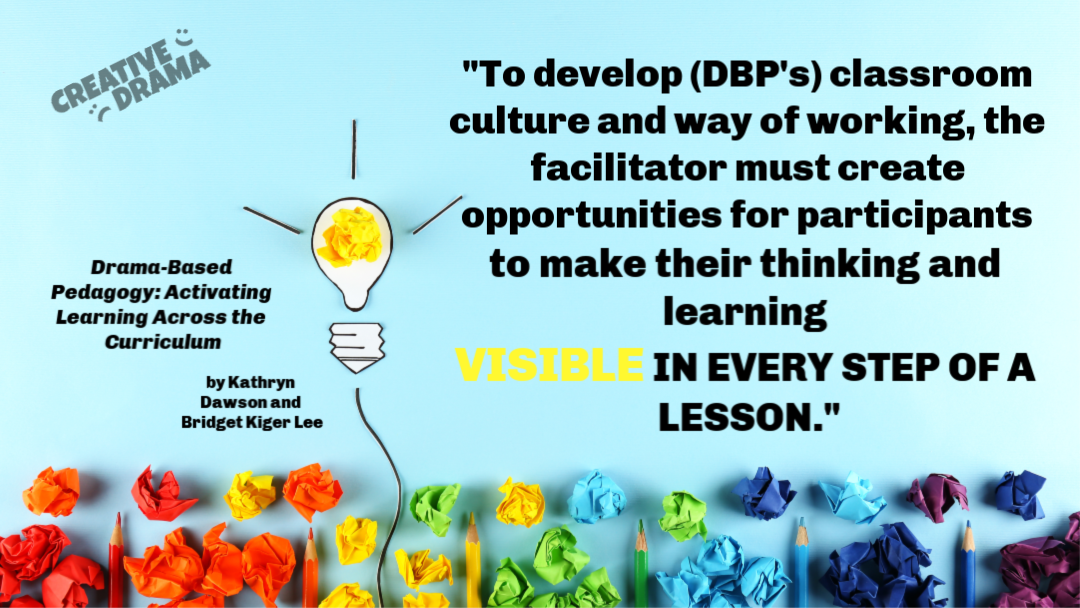
CHAPTER 4: Activating Dialogue
Activating Dialogue strategies have students using a variety of dialogue types to connect their prior knowledge and experience to content. An important component of these strategies is that they make “learning visible.” Dawson and Lee see the activities as a way to help students “author understanding.”
Teachers familiar with traditional lesson plan organization will recognize that the strategies often fit the purposes of the “Anticipatory Set” or “Closure” activities.
The strategies in Chapter 4: Activating Dialogue have 3 sub-categories:
- Rituals to Begin and End
- Text-Based/Visual Dialogue
- Embodied Dialogue
Rituals to Begin and End
The “Rituals to Begin and End” subcategory has 8 strategies. I used to call the “Check-in” (62-63) activity “Acknowledgements;” I’ve also heard it called “Roses and Thorns.” Using it as an everyday ritual, but not insisting on having every student contribute every time, is a good way to build camaraderie in a class. “It Made Me Think” (65-66) is a public “Ticket Out the Door” where students supply one moment or thing learned from the class.” It looks like “Words of Wisdom” would work well for an improv class, with its simultaneous, full-class “YES!”
Text-Based/Visual Dialogue
In Text-Based/Visual Dialogue strategies, students respond to written or visual messages in verbal, visual, or written modalities. One of the considerations teachers should take into account is the students’ ability to read and understand the messages. “Snowball” (83) would be especially appealing to students reluctant to share their thoughts with the class and could be an opening or closing activity. There are 7 strategies in this section.
Embodied Dialogue
Most of the “Embodied Dialogue” strategies require movement from students. Participants place themselves on a continuum in classroom space. Dawson and Lee have a special “Spotlight on Sociometrics in DBP.” included because 4 of the 6 strategies use a variation of sociometric. The authors even provide a chart to help teachers “pick the best” (89) that lays out the levels of Student Risk, Cognitive Complexity, and Space Required for each. In “How to Facilitate an Effective Sociometric,” the teacher uses “Exploding Atom;” those unfamiliar with the exercise will still be able to follow along.
Reading through the strategies really got my creativity flowing; I started wondering how one could incorporate or adapt an “Urgent Important Matrix” into an Embodied Dialogue strategy.
Chapter 5: Theatre Game As Metaphor
Theatre Game as Metaphor is a way of building a “pro-social culture” in a classroom. Students work on: Building Ensemble, Representing Concrete Ideas, and Practicing Drama/Theatre skills.
The 3 sub-categories for Theatre Game As Metaphor are:
- Ensemble, Energy, and Focus
- Setting, Story, and Character
- Conflict, Power, and Problem-solving
Theatre Game As Metaphor strategies require that participants have “bought in” to being “theatrical/dramatic;” more so than in the Rituals to Begin and End ones.
Ensemble, Energy, and Focus
The 21 (!) games in Ensemble, Energy, and Focus are mostly “warm-ups.” They help particularly with the affective domain and team-building. In “Spotlight on Facilitation” the example Dawson and Lee provide is a 3rd grade teacher using “The Truth About Me” (140) to help students connect animal adaptations to specific habitats. The process the authors suggest is:
- Play the Game “Regularly” – Participants as themselves, using personal knowledge
- Teach the Content – Participants, in groups, get an image and information about an animal.
- Play the Game “Conceptually” – “The Truth About (INSERT ANIMAL HERE).”
Many of these strategies are cooperative games; even “Zip, Zap, Zop” (145), which has an elimination variant, gets the “everybody wins” treatment here.
Setting, Story, and Character
For the 8 strategies in “Setting, Story, and Character,” students may need instruction in specific drama skills, such as voice, pantomime, or imaginative narrative. As with “Ensemble, Energy, and Focus,” most of these strategies are meant to be played simultaneously by class-sized groups.
However, the pair strategy “Gift-giving” (150) is a lesson in the improv tenet “Say Yes!” that seems like it could have some class members (particularly the more reluctant ones) watch others do first.
The variations for “In the Manner of the Adverb” (155) are terrific and wide-ranging.
Conflict, Power, and Problem-solving
Students work together to bring the abstract into concrete representation in these 8 strategies. Reflection and analysis requires some metacognition, and educators will need to help students navigate conflict, especially because conflict is “the point” for some strategies.
I expected to find more “new-to-me” games in this section, especially because I don’t have formal training in Theatre of the Oppressed. “Columbian Hypnosis” (164) and “Defender” (165) are the only two that weren’t familiar.
CHAPTER 6: Image Work
In the Image Work category, students create or use an object representationally. A key word for Image Work is multiplicity; through their work, students:
- Explore multiple ways of making meaning
- Discover multiple perspective
- Think about multiple facets of lesson content
The academic domain in Image Work is slightly more significant than in previous categories. Students use the DAR (Describe, Analyze, Relate) meaning-making routine often.
Object as Image
The subcategory’s 4 strategies utilize a prop (object) or visual (photograph, illustration) as a visual representation.
The example Dawson and Lee give is a first grade teacher choosing to create a “Character Bag” – a multiple-item version of the “Artifact” (189) strategy – for the protagonist of Barbara M. Joosse’s Ghost Wings. In the planning materials, the authors explained how one could “toggle” back and forth between “Describe” and “Analyze” when dealing with multiple objects. I started thinking about how in a high school English Literature class, students might be able to create character bags on their own after reading a work.
“Object as Metaphor” (191) provides lots of possibilities – students could speak “in-role” as a character or author responding to the question. “The Great Game of Power (192) gives out-of-the-box thinkers an opportunity to shine.
Body as Image
The “Body as Image” subcategory asks participants to use themselves and others to create representations of characters, ideas, relationships, events, even vocabulary. Space is a consideration in choosing strategies, although the stillness of each activity result means that students can work within the constraints of a classroom fairly easily. Tableau is a strategy that fits into this subcategory..
Images in Action
“Images in Action” is similar to “Body as Image,” but now the images can move. “Complete the Image” (209) would be a great introduction to the classic improv game “Freeze” which is often tricky for beginning actors. The DAR work students do during Image Work will help them see more possibilities for interpreting images.
Dawson and Lee share a response method to presentation in “Images in Action” that’s framed as “I appreciate/I discovered/I wonder.” It would be as useful in scene or play critiques as it would in response to short class presentations.
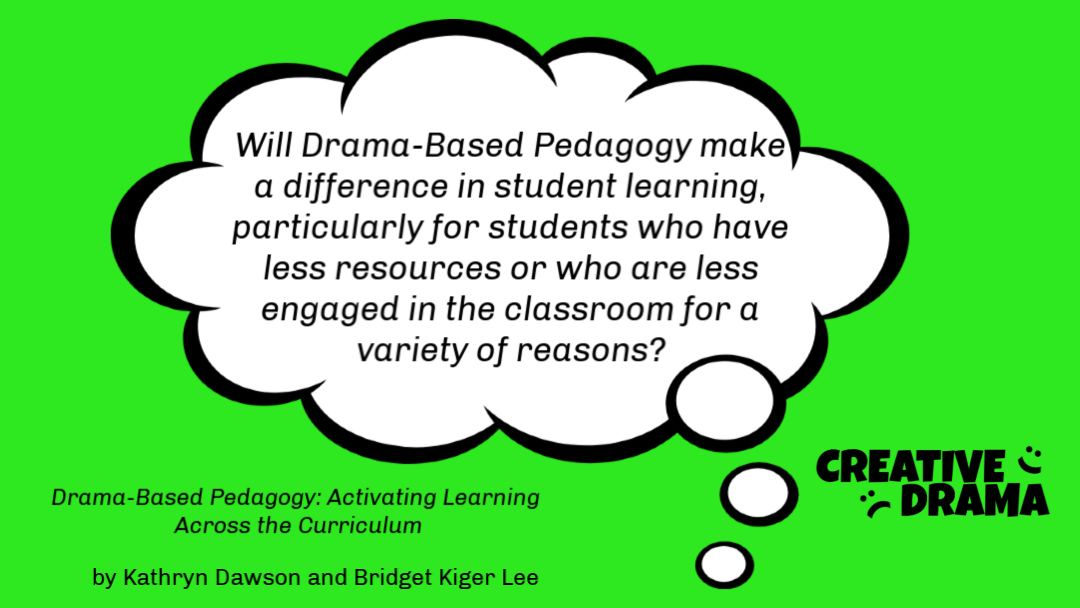
Chapter 7: Role Work
Dawson and Lee increase students’ use of imagined circumstances in “Role Work.” They say that it’s “a collection of strategies that brings together the full potential of what drama can do across the curriculum.” (225) “challenge is finding a story/problem that lends itself to the potential of a dramatic dilemma.” (224)
Creating Context and Subtext
In “Creating Context and Subtext,” the 7 strategies have students using multiple modalities “to infer, explore, and reflect” (227). My earlier “a-ha!” moment regarding “Character Bags” from Chapter 6 turned out to be an actual strategy “Objects of Character” (232) in which participants collect objects for a chosen character.
Performing Character
The 6 activities in “Performing Character” get students-in-role and teachers-in-role. Two of the areas of awareness Dawson and Lee point out for teachers are the “Teacher Structure” and “Student Choice” continuums; they suggest starting with high-structure, low-choice strategies. “Conscience Alley” (245) reminded me of Brian Edmiston’s expanded “Consciousness Threes” exercise from Transforming Teaching and Learning with Active and Dramatic Approaches. Hot-seating, Writing-in-Role, and improvised scenes also fit into the “Performing Character” strategies.
Performing Within a Dramatic Dilemma
The hypothetical situation becomes a lived experience in “Dramatic Dilemmas.” These 6 strategies create a fictional frame in which students take on the roles of characters from literature, types of citizens, or even experts in a field. Dawson and Lee suggest creating dilemmas with:
- High Stakes
- Distance (psychological & emotional)
- Multiple possible viewpoints
- A mid-level power role for the teacher
With “Dramatic Dilemmas,” the common “Advertising/Design Pitch” (260) and “Public Service Announcement” (263) projects become more than just a poster or commercial as students take on the roles of designers and invested parties.
PART III: HOW IS DBP USED?
Dawson and Lee begin Part III with a Review of the DBP Approach in Chapter 8. They’ve condensed the 5-steps into a handy one-page list that teachers can copy into a template for following.
Chapter 9: “Examples of DBP Learning in Action”
Chapter 9: “Examples of DBP Learning in Action” presents four teachers applying the DBP process to subjects across curricula and grade levels. The examples detail how the teachers developed their plans, why they made certain choices, and even script (write out what teachers say) parts of the lessons.
Dawson and Lee choose:
- A Kindergarten teacher using Molly Bang’s When Sophie Gets Angry – Really, Realy Angry as both a emotional intelligence and literacy skills lesson
- A 10th Grade U.S. History instructor using Lincoln’s Gettysburg Address; there are a number of students who require highly-structured learning situations in the class
- A 5th Grade teacher in a dual-language program using a dramatic situation to help students buy in to Geometry.
- A 10th/11th grade Earth Science teacher at a boarding/day school in Alaska who wants to assess students’ understanding of energy sources and cultural knowledge
In addition to the plans, each application example provides “Other Examples from the Field” showing other teachers adapting the lesson for other ages or ability levels, or adopting a similar approach to different content.
Chapter 10: Further Considerations
Dawson and Lee end Part III with a brief look at other aspects of DBP learning design. They begin with the student-teacher relationship in DBP, providing a chart with examples of:
- Desired Student Outcomes
- Instruction and Side-Coaching Language
- Meaning-making Language
for each type of teacher/student relationship:
- Guide on the Side (Co-Facilitators)
- Direct Guide (Facilitator/Participant)
- Full Participation (Co-Participants)
Note that there is NO “Sage-on-the-Stage” option in DBP!
The next section covers “Areas of Differentiation” in DBP
- Content Level
- Process/Activities
- Product/Assessment
- Environment
- Emotional Engagement
- Participant Choice
- Physical Activity
- Group Size
Finally, Dawson and Lee give “big picture reminders” (330); it’s good to see the one about “Unexpected Responses” even though there weren’t any examples of things going “off the rails” in the rest of the book.
APPENDICES
The appendices in Drama-Based Pedagogy are FULL of further resources; I looked up Lee’s meta-analysis of past DBP studies that’s referenced in the Epilogue and credited in “Related Sources,” but I haven’t had a chance to read through all 47 pages yet!
The glossary makes for a great review of terminology, both specific to DBP and general for education/theatre education.
Most of the citations for “Online Resources” are from Drama-Based Instruction at the University of Texas; it’s a great place to find more information and there are videos!
RECOMMENDATION
I agree with Brian Edmiston’s assessment of Drama-Based Pedagogy. I too wish I could have had a book like this when I began teaching! It would have given me much-needed support and confidence to pursue strategies that keep students active and learning.
A teacher could easily incorporate most of the strategies into lesson plans, even the most formal ones. The authors provide so much information, tips and ways to make the strategies work that it will be easy to pair them up with standards.
Even when I encountered already-familiar strategies in Drama-Based Pedagogy, I discovered ways to incorporate them into lessons that I hadn’t thought of before.
I highly recommend Drama-Based Pedagogy for any teacher-director or teacher looking to integrate a dynamic learning method to her classes.
ABOUT THE AUTHORS
Bridget Kiger Lee is an assistant professor in Applied Psychology at the University of Pittsburgh. She has an M.F.A. in Drama and Theatre for Youth and Communities and a Ph.D. in Human Development, both from the University of Texas at Austin. She received her Bachelor of Science degree in Theatre and Learning Disabilities at Northwestern University.
She has her own website at BridgetKigerLee.com
Kathryn (Katie) Dawson is an assistant professor in the Department of Theatre and Dance at the University of Texas at Austin. She directs the Drama for Schools program, which is a professional development (teacher training) program model in DBP.
Dawson won a Regents’ Outstanding Teaching Award from the UT-Austin Class of 2019. With Daniel A. Kelin, II, she co-authored The Reflexive Teaching Artist, which won the 2015 Distinguished Book Award from the American Alliance of Theatre and Education. She is also the recipient of 2013 Creative Drama and 2006 Winifred Ward Scholar Awards from AATE.
